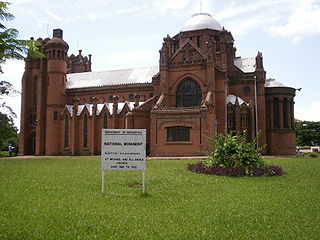Religion in Trinidad and Tobago, which is a multi-religious country, is classifiable as follows:
Christianity is the largest religion in Mozambique, with 62% of the population in 2023. More than half of these are evangelical and Pentecostal Christians.
Protestantism in Puerto Rico officially was introduced in 1872 when the first Protestant church in the Anglican tradition was established on the island. Before the islands of Puerto Rico came under United States sovereignty in 1898, Protestantism was suppressed under Roman Catholic Spanish rule.

Protestantism in Brazil began in the 19th century and grew in the 20th century. The 2010 Census reported that 22.2% of the Brazilian population was Protestant, while in 2020 the percentage was estimated to have risen to 31% of the population, over 65 million individuals, making it the second largest Protestant population in the Western world.

There are around 500,000 to 1,000,000 Protestants in Egypt, with 300,000 to 600,000 being members of the Evangelical Church of Egypt, Pentecostals number 300,000 to 350,000, and various other Protestants scattered in smaller denominations.
Protestants are about 2,009,374 in Sudan. They are forbidden to proselytize. The law makes apostasy punishable by death. The southern ethnic groups fighting the civil war largely are followers of traditional indigenous religions or Christians.
The population of Angola is more than 92% Christian in 2023.

Christianity is the predominant religion in Zambia and is recognised as the state religion by the country's constitution. Before the arrival of European missionaries, the various ethnic groups residing in the territory of modern day Zambia practiced a variety of African traditional religions.
Protestants in the Dominican Republic represent a sizeable minority of the population.

Protestantism is the dominant religion in Jamaica. Protestants make up about 65% percent of the population. The five largest denominations in Jamaica are: Church of God, Seventh-day Adventist, Baptist, Pentecostal and Anglican. The full list is below. Most of the Caribbean is Catholic; Jamaica's Protestantism is a legacy of missionaries that came to the island in the 18th and 19th centuries. Missionaries attempted to convert slaves to varying Protestant denominations of Moravians, Baptists, Methodists, and Presbyterians to name a few. As missionaries worked to convert slaves, African traditions mixed with the religion brought over by Europeans. Protestantism was associated with black nationalism in Jamaica, aiming to improve the lives of blacks who were governed by a white minority during colonial times. Today, Protestantism plays an important role in society by providing services to people in need.

Christianity is the most widely professed religion in Chile, with Catholicism being its largest denomination. The country is secular and the freedom of religion is established under its Constitution.

Religion in Guyana is diverse, with Christianity being the most widely professed faith.

According to the 2011 census, Christianity was adhered to by 20.7% of the population of Mauritius; 80.3% of these were Roman Catholics.
A 2020 Pew Forum survey estimates that approximately 63% of the population of Tanzania identifies as Christian, 34% as Muslim, and 5% practitioners of other religions. Most Christians are Catholics and Lutherans, although there are also Anglicans, Pentecostals and other groups.

Christianity was introduced by Spanish settlers who arrived in Jamaica in 1509. Thus, Roman Catholicism was the first Christian denomination to be established. Later, Protestant missions were very active, especially the Baptists, and played a key role in the abolition of slavery.

Christianity is the religion with the largest following in Ghana. Christian denominations include Catholics, Methodists, Anglicans, Presbyterians, Lutherans, Seventh-Day Adventists, Pentecostals, Baptists, Evangelical Charismatics, Latter-day Saints, etc.

Christianity is the largest religion practiced in Zimbabwe, accounted for more than 84% of the population. The arrival of Christianity dates back to the 16th century by Portuguese missionaries such as Fr. Gonsalo Da Silveira of the Roman Catholic Church. Christianity is embraced by the majority of the population. It is estimated 85 percent of Zimbabweans claim to be Christians, with approximately 62 percent regularly attending church services. Christian faith plays a very important role in the organization of Zimbabwean society.

According to the 2018 census, 77.3% of the population is Christian. Denominations include Roman Catholics at 17.2% of the total population, Central Africa Presbyterians at 14.2%, Seventh-day Adventist at 9.4%, Anglicans at 2.3%, Pentecostals at 7.6% and other denominations at 26.6%.










